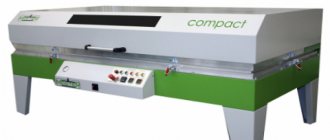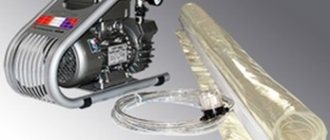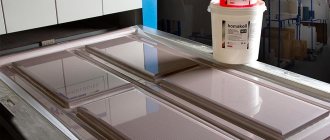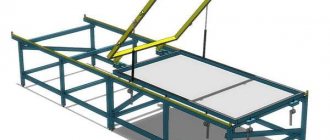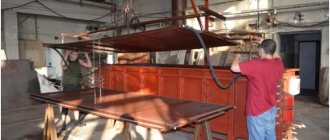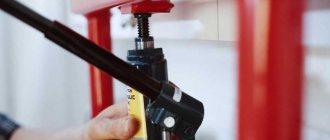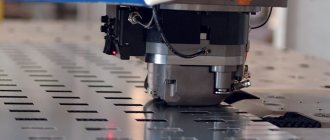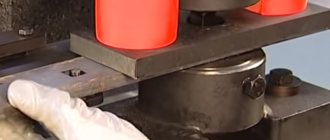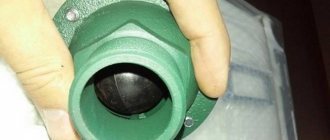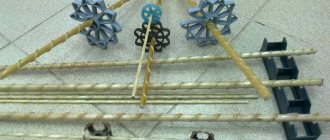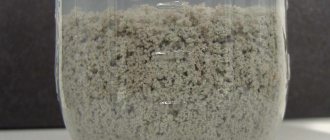Characteristics and advantages of membrane vacuum presses
Organization of production for serial production of furniture and carpentry is impossible without modern equipment.
Requirements for products have increased significantly, and buyers meticulously evaluate the quality of curved facades and the appearance of curly profiles. In order to make the product competitive and not receive complaints from consumers regarding poorly made cladding, enterprises need to purchase a vacuum press. The equipment simultaneously allows you to expand the range, reduce the percentage of defects to a minimum and optimize production processes as much as possible. The main criteria for high-quality cladding are indicators of long-term durability of the coating, decorative characteristics and absence of surface damage. The vacuum press not only allows processing of three-dimensional and two-dimensional profiles in accordance with the specified requirements, but also helps to significantly minimize production costs. The equipment is used in carpentry and furniture enterprises to create:
- facades of furniture and molded products;
- bent glued parts;
- platbands, countertops and door trims;
- curly, angular and rounded profiles.
A vacuum press for facades is capable of providing a monthly output of finished products in quantities from 100 to 150 sq.m., and with maximum load and rational use, significantly increase the performance. The units provide uniform heating of the workpiece surface, are characterized by short processing time to obtain reliable results and a simple control method that eliminates the possibility of errors and defects.
We are starting a series of articles devoted to the issues of self-manufacturing a vacuum press for the production of furniture facades from MDF, coated with PVC films (film facades), as well as decorative door trims. All material in the articles was based on personal experience in organizing the production of film facades from scratch, including making the vast majority of equipment and fixtures with your own hands. The material in the articles does not claim to be absolutely accurate and true, but only describes one specific (special) case and an individual vision of the issues under consideration.
The articles will touch upon issues directly related to the manufacture and operation of a homemade vacuum press; related topics (for example, milling facades, applying glue, etc.) are planned to be considered in other, separate articles.
Information presentation plan:
- Theoretical foundations of vacuum pressing of PVC films. The production is perfect for her. What kind of press are we building?
- Stand on.
- Vacuum table.
- Air pumping system (vacuum system).
- Thermal module.
- Electrical control cabinet.
Before starting the story, it is necessary to warn potential press repeaters about the possible risk to their health. Making your own is a good thing, we always welcome it, but we must not forget about safety precautions. While working on the manufacture of a press, you will have to deal with electrical voltages of up to 400 V, high temperatures, high-risk power tools, and massive, heavy metal structures. Be aware of your own actions! Soberly evaluate your knowledge and skills! If you have doubts about the correctness of a particular operation, be sure to consult with a specialist or completely delegate the work to him. Do not neglect personal protective equipment; it is better to purchase all the essentials in advance: welder’s clothing and mask, glasses or a mask to protect the eyes and face, durable gloves for working with metal, headphones to reduce sound pressure on the ear.
Theoretical foundations of vacuum pressing of PVC films.
Film facades have been used for a very long time in the manufacture of cabinet (sometimes hard elements of upholstered) furniture, but are still very popular due to their rich color range, variety of shapes and low price. Unlike some other types of furniture facades (for example, frame ones), film facades are manufactured only using specialized equipment, which requires considerable production space and energy supply. The main machine in the production of MDF facades covered with PVC films is rightfully considered a vacuum press. A vacuum (often called a thermal vacuum) press shrinks a PVC film onto the surface of an MDF workpiece (facade, door trim, etc.).
Any thermal vacuum press for the production of film facades consists of two main elements: a vacuum chamber (table, bath) and a heater (thermal module). The vacuum chamber, as a rule, has a rectangular shape (parallelepiped), all walls (except for the top) are made of rigid material (for example, steel) that is not subject to compression under the influence of artificially created negative pressure inside the chamber. PVC film is placed on top of the chamber, the edges of the film are sealed with the frame. Thus, we get a sealed volume: there is a sheet of PVC film on top, and a rigid vacuum chamber on the bottom and sides. Before covering with PVC film and sealing the internal volume of the vacuum bath, blanks of future furniture facades, pre-coated with a special heat-activated glue, are placed in the internal space of the vacuum bath in a certain way. At room temperature, PVC film is very rigid; without heating, it will not be able to wrap around the entire relief of the workpiece. Also, without heating, the film will not be able to stick to the workpiece, since the activation temperature of the glue starts at 50°C. Electric heating devices (infrared incandescent lamps or heating elements) are used to heat the film. The total power of all heating devices is high and, as a rule, ranges from one to several tens of kilowatts.
Factory-made thermal vacuum press with vertical raising of the thermal module. Essential elements.
Note: there are presses with the so-called. upper pressure, they, in addition to pumping air from a sealed chamber from below, have another chamber above the film, into which air is pumped in excess of atmospheric pressure (additional pressure is applied to the film from above). Such presses, of course, compare favorably with a number of characteristics compared to presses without upper pressure. However, such equipment is much more difficult to manufacture independently and will not be considered in this series of articles.
So, the process of shrinking (they also say stretching) the film consists of the following sequential basic operations:
- Laying blanks on the press table.
- Covering with PVC film, sealing.
- Heating the film to a certain temperature.
- Pumping out air.
- Cooling.
- Cutting blanks, removing excess film from facades.
With a well-functioning production process, a typical stretch of one table (from covering with film to cutting out the finished facades) takes no more than 10 minutes. However, in order to achieve such results, working on a homemade vacuum press, you need to have a very large skill, a number of experimental data on drawing a particular type of film, obtained on the basis of your own trial and error. It is strongly recommended to thoroughly weigh all the pros and cons, and take on making a press with your own hands only in conditions of strict financial savings, availability of free time, great desire, and self-confidence.
Furniture facades are made using a homemade press.
The door linings are made using a homemade press.
Setting goals. What kind of press are we building?
Before proceeding directly to the manufacture of the press, it is necessary to set the final goal, that is, to determine with what characteristics, capabilities and at what cost we should ultimately obtain a homemade vacuum press.
Anyone who has ever seriously thought about making any industrial equipment with their own hands, first of all compared the cost of self-production with the price of a similar ready-made industrial (factory) model. It is very important here to make the right choice, to try to answer the question “is the game worth the candle?” By overestimating your own strengths, you can irrevocably lose not only the money invested, but also a lot of invaluable time. By making an informed choice in favor of self-production, you can save a lot while gaining new knowledge and life experience.
Today, you can buy an entry-level thermal vacuum press for relatively little money. For any successful enterprise, the issue of maximizing extreme savings of money is not an urgent issue; the time spent and other aspects are more important, therefore, without hesitation, the decision is made to purchase ready-made equipment. But what should a beginning private (individual) entrepreneur or a newly formed small organization that is just entering the market and often has to count every ruble do? Professional economists can offer to develop a competent business plan, conduct marketing and other research, and take out a bank loan for the required amount. This strategy is perhaps more correct and is increasingly used in our time, suggesting a quick start and a quick return on investment. However, each specific case is individual. Sometimes, due to a combination of many reasons, it is more logical to make a less popular decision: a minimum of borrowed funds, a maximum of investing your own strength and skills. This series of articles is mainly addressed to followers of this path.
If the fascinating process of making a press is not an end in itself, but the main thing is to quickly make a profit from its future operation, then there is no need to try to copy any of the latest, advanced model of a factory press from a well-known manufacturer. We will make a press that has only the most necessary functions, with a cost close to the minimum possible (with reasonable savings). Let’s consolidate the basic postulates of building a press:
- The service life of the press is about five years. In the future, it is planned to purchase more advanced equipment or deeply modernize the existing one.
- High maintainability. Short deadlines for eliminating possible malfunctions, including with regard to the timing of purchases of spare parts.
- No automatic or program control, only manual control.
- Use of the most common, easily accessible materials and components.
- Design and external beauty are secondary.
- The convenience and speed of working on the press should be comparable to similar characteristics of factory analogues.
- The saved monetary difference between the cost of manufacturing a press and the price of a factory analogue should be at least significant for the enterprise.
The approximate time that will be spent purchasing components and completing all work is one to three months. We will need to obtain a reliable and easy-to-use thermal vacuum press for the production of the most popular (traditionally in good demand) types of furniture film facades and door overlays based on MDF. With proper planning of purchases and performance of work of appropriate quality, the cost of a homemade press (at the time of publication of the article) should be at least two times lower than the price of any similar factory-made vacuum press.
Similar articles:
- Connection strip for film
- DIY vacuum press. Part VI. Electrical control cabinet
- DIY vacuum press. Part V. Thermal module
- DIY vacuum press. Part IV. Vacuum system
- DIY vacuum press. Part III. Vacuum table
- DIY vacuum press. Part II. bed
- Gluing glass into MDF facades
Types of equipment and features of models
Varieties of vacuum heat presses make it possible to freely select an installation with the necessary technical characteristics. Regardless of the model, the equipment guarantees the complete integrity of the treated surface and the quality of the cladding when used:
- matte or glossy polymer films;
- veneer and plastic;
- melamine paper.
Due to the use of negative pressure and high temperature in the technological process, the machines provide a smooth and stepless cladding method. The units are produced with different numbers of heating elements, with placement features and different power ratings. The presses are equipped with spiral heating elements or devices with infrared emitters. The equipment is used in thermal or cold processing mode, using a membrane or for conventional decorative cladding of surfaces.
In installations with manual control mode, the heating element and vacuum pump are started and the air supply speed is adjusted by personnel. Automated machines are equipped with an electronic control panel and operate in accordance with the programmed program, requiring only the laying of parts and cutting of the film at the last stage. Much in the operation of the machine depends on the material used to make the membrane. Compared to rubber and caoutchouc, silicone exhibits greater elasticity and heat resistance, allowing for an increase in the number of technological operations.
For large production volumes, additional devices with useful and convenient functions are indispensable in the design of a thermo-vacuum press:
- Unwinding device. Manual or automatic cutting of facing material.
- Magnetic supports. Stable position of the workpiece in the work area.
- Antistatic brushes. Elimination of static charge from the surface of the film, cleaning of dust and small debris.
Various manufacturers include additional equipment for recycling industrial waste, mobile racks for transporting and storing consumables. It is economically profitable to purchase a membrane-vacuum press with a device for performing routine repairs of silicone gaskets. Quick repair of minor damage and membrane ruptures makes it possible not to stop the work process for a long time.
Membrane for vacuum press
Diaphragms for such devices are made of natural rubber or industrial silicone, and are used when veneering furniture surfaces or for covering them with protective PVC film of various colors.
Membrane for vacuum press
When finishing with veneer, membranes are used to increase the pressure exerted on the workpiece and the veneer when they are firmly connected. In addition, the diaphragm ensures a secure position without shifting the covering material. When covering similar surfaces with thin PVC films, diaphragms reliably protect them from active thermal energy.
The industry favors silicone diaphragms because they are highly durable and can effectively coat fairly small parts.
Basic rules for choosing a vacuum heat press
Before making a final decision in choosing a modification of a membrane-vacuum press, you should compare production goals with the characteristics of the machine and analyze:
- expected working volume;
- product ranges;
- the size of the production premises.
Depending on the listed indicators, the dimensions of the installation, the size of the working surface and the design of the equipment are determined. For small workshops, units with a retractable table top or a vertical lift of the pressing device are more suitable. In a sufficiently free room, installing an additional work table can increase press productivity by almost 50%.
In order to prevent sudden flows of cold air to the treated surface when opening the unit, it is worth acquiring a vacuum heat press with a pneumatic device for lifting the upper part. Manufacturers use different types of pumps to operate machines, and the design of some models is complemented by compressor equipment. The best option is an oil-fed pumping station, which shows increased performance compared to oil-free systems. The strength of water ring devices is their low cost, but this design reduces the efficiency of the press.
Vacuum pressing technology
Thanks to membrane-vacuum pressing technologies, it is possible to effectively cover various parts used in furniture production with various types of decorative films. In this case, the surfaces being coated can have a deep relief. The technology of membrane-vacuum pressing is quite complex, so the manufacturer must provide all the necessary conditions for high-quality work. Particular attention is paid to the quality of materials used in membrane vacuum molding.
In furniture production, this technology is used when covering various surfaces with PVC films. Lining occurs using vacuum presses, which can be either with or without a membrane. PVC films can have a thickness from 0.25 to 0.5 mm.
To apply glue and dry parts, you need a separate room, which must be equipped with an exhaust chamber with a dry filter or a hydraulic curtain. The chamber for applying glue must be kept perfectly clean; wet cleaning according to technology is carried out every two hours. If possible, excess pressure should be created in the chamber, which will prevent dust from entering from other rooms.
Silicone membrane for vacuum press
Such products are characterized by high strength and elasticity, therefore they ensure efficient operation of the press. The thickness of the product varies from 0.1 to 10.0 mm, but membranes with a thickness of 2-3 mm are produced for vacuum presses, because such products have high elasticity, sufficient stretch and great strength.
Silicone membrane for vacuum press
For example, the elongation coefficient for technical silicone is chosen to be of average parameters up to 750%. Do not forget the hardness indicators, which for silicone membranes range up to - 50 A.
The color scheme of the membrane does not change the quality of the film or veneer being pasted, and silicone diaphragms are available in a transparent form.
Basic properties:
- gas permeability is 20% higher;
- breaking force - up to 80 kgf/cm2;
- density - 1.2 g/cm3;
- stretching - 100-120 bar.
Silicone membranes have a long service life when used at temperatures not exceeding 180° C.
